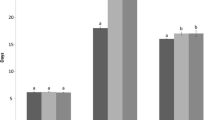Abstract
An artificial diet for rearing the spotted bollworm, Earias vittella (Fabricius) was developed under laboratory conditions (temperature 27 ± 1 °C, RH 60 ± 5% and 16:8 h scoto /photophase regime). The diet ingredients consisted of wheatgerm (5 g), seeds of cotton (Gossypium hirsutum L. var. Pusa 8–6) (50 g) and chickpea (Cicer arietinum L. var. Kabuli)(35 g) as base materials along with agar-agar (15 g), dried yeast powder (8.0 g), methyl-p-hydroxybenzoate (1.0 g), l-ascorbic acid (1.2 g), sorbic acid (1.0 g), cholesterol (0.2 g), streptomycin sulphate (0.2 g), and multivitamin multimineral and vitamin E capsules (one each). After rearing neonates on okra for 3–4 days, the diet supported the growth and development of E. vittella successfully for eight generations. Larval development on this diet was completed in 11.9 ± 0.66 days against 11.64 days on the pest’s preferred natural host, okra (Abelmosclms esculentiis) Moench. The growth and developmental indices on the artificial diet for the eight generations are reported.
Résumé
Un milieu nutritif artificiel a été mis au point pour l’élevage d’Earias vittella (Fabricius) dans des conditions de laboratoire (T0 = 27 ± 1°C, HR 60 ± 5% et à un régime de 16 h d’obscurité et 8 h d’éclairage. Le milieu nutritif consistait en produits de fond dont: le germe de blé (5 g), les graines de coton, Gossypium hirsutum L. var. Pusa 8–6 (50 g), le pois chiche (Cicer arietinum var. Kabuli) (35 g). A ces produits de fond, on a ajouté de l’agar-agar (15 g), la levure en poudre (8, 0 g), le méthyl-p-hydroxybénzoate (1,0 g), l-acid ascorbique (1,2 g), l’acide sorbique (1,0 g), le cholestérol (0,2 g), le sulfate de streptomycine (0,2 g); et des comprimés: multivitamine, multiminéral et vitamine E (un de chaque espèce). Après élevage des chenilles neonates sur le gombo pour 3–4 jours, le milieu artificiel a positivement stimulé la croissance et le développement de E. vittella pour huit générations successives. Le développement de l’état larvaire sur ce milieu durait 11,9 ± 0,66 jours contre 11,64 jours que prend ce développement, une fois l’insecte nourri sur le gombo (Abelmoschus esculenlus) Moench., son hôte naturel favorit. Les indices de croissance et de développement sur milieu artificiel pour les huit générations sont exposés.
Similar content being viewed by others
References
Gupta, B. D. (1978) Differentiation of sex in pupae of spotted bollworm, Eariasfabia (Stoll) (Lepidoptera: Noctuidae-Erastriinae). Current Sci. 47, 642.
House, H. L. (1967) Artificial diets for insects: A compilation of references with abstracts. Inf. Bull. Res. Inst. Can. Dep. Agric. Belleville Ontario 5, 163 pp.
Mehta, R. C. (1977) Earias Vittella (F.), pp. 478–479. In Diseases, Pests and Weeds in Tropical Crops (Edited by J. Kranz, H. Schmutterer and W. Koch). Paul Parey, Berlin and Hamburg.
Pant, J. C. and Anand, M. (1972) An artificial diet for the spotted bollworm Earias fabia Stoll. Entomol. Newsl. 2, 45–46.
Paul, A. V. N., Parshad, B. and Gautam, R. D. (1987) An artificial diet for Pectinophora gossypiella (Saund.) and Earias Vittella Fab. bollworms of cotton. Indian, J. Agric. Sci. 57, 189–192.
Peter, C. and Nagarkatti, S. (1985) Development of an artificial diet for rearing the spotted bollworm Earias vittella (Noctuidae: Lepidoptera). Entomon 10, 117–119.
Rup, P. J. and Sidhu, H. S. (1980) Laboratory rearing of spotted bollworm of cotton Earias Vittella (F.) (Lepidoptera: Noctuidae) on artificial diets. J. Res. Punjab Agric. Univ. 17, 282–285.
Saxena, R. C. and Khan, Z. R. (1974) Patterns of relationship between certain leaf hoppers and plants. Entomol. Exp. appl. 17, 303.
Sharma, H. C. and Agarwal, R. A. (1982) Effect of some antibiotic compounds in Gossypium on the post-embryonic developmentof spotted bollworm (Earias vittella). Entomol. Exp. appl. 31, 225–228.
Singh, P. (1977) Artifical Diets for Insects, Mites and Spiders. IFI/Plenum Data Company, New York, Washington, London. 549 pp.
Tamhankar, A. J. (1986) Studies on the reproductive behaviour of Earias Vittella (Fab.) and Earias insulana (Boisd.) and factors governing their reproductive isolation. PhD Thesis. Mahatma Phule Agricultural University, Rahuri, Maharashtra.
Tamhankar, A. J., Shantharam, K., Harwalkar, M. R. and Rahalkar, G. W. (1992) Development of an artificial diet for the laboratory rearing of the spotted bollworm, Earias Vittella (Fab.) (Lepidoptera: Noctuidae). Insect Sci. Applic. 13, 241–243.
Vanderzant, E. S. (1974) Development, significance and application of artifical diets for insects. Annu. Rev. Entomol. 19, 139–160.
Wyniger, R. (1962) Pests of crops in warm climates and their control. Acta tropica Suppl. 7 Verlag für Recht. Und Gesselschaft AG, Basel.
Author information
Authors and Affiliations
Corresponding author
Rights and permissions
About this article
Cite this article
Gupta, G.P., Mahapatro, G.K. & Chandra, A. Partial Larval Rearing of Earias vittella (Fabricius) on Artificial Diet. Int J Trop Insect Sci 18, 371–375 (1998). https://doi.org/10.1017/S1742758400018610
Accepted:
Published:
Issue Date:
DOI: https://doi.org/10.1017/S1742758400018610




